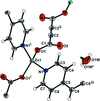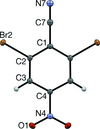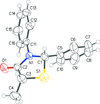issue contents
November 2017 issue

Cover illustration: In poly[[(![[mu]](/logos/entities/mu_rmgif.gif) 2-oxalato)[
2-oxalato)[![[mu]](/logos/entities/mu_rmgif.gif) 2-1,2-(pyridin-4-yl)ethylene]zinc(II)] dihydrate], {[Zn(
2-1,2-(pyridin-4-yl)ethylene]zinc(II)] dihydrate], {[Zn(![[mu]](/logos/entities/mu_rmgif.gif) 2-C4O4)(
2-C4O4)(![[mu]](/logos/entities/mu_rmgif.gif) 2-C12H10N2)]·2H2O}n, 2-butyndioate and 1,2-bis(pyridin-4-yl)ethylene ligands bridge ZnII ions to form a three-dimensional network. The three-dimensional networks are fivefold interpenetrated, and each network features a 4-connected unimodal net with a Schläfli symbol of 66 (dia) with the ZnII ions as the nodes. Twofold rotation axes are located at the ZnII ions and the midpoints of the C
2-C12H10N2)]·2H2O}n, 2-butyndioate and 1,2-bis(pyridin-4-yl)ethylene ligands bridge ZnII ions to form a three-dimensional network. The three-dimensional networks are fivefold interpenetrated, and each network features a 4-connected unimodal net with a Schläfli symbol of 66 (dia) with the ZnII ions as the nodes. Twofold rotation axes are located at the ZnII ions and the midpoints of the C![[triple bond]](/logos/entities/z-tbnd_rmgif.gif) C bond of 2-butyndioate and the C=C bond of 1,2-bis(pyridin-4-yl)ethylene. The coordination geometry around the ZnII ions is tetrahedral constructed from two O atoms from 2-butyndioate and two N atoms from 1,2-bis(pyridin-4-yl)ethylene. Solvate water molecules are connected with each other via hydrogen bonds to create chains running parallel to [010] that are captured in infinite channels of the three-dimensional framework through hydrogen bonds to the non-coordinating carboxylate O atoms of the 2-butyndioate units. The water molecules are disordered, with two alternative positions that are distinguished by the direction of the chains, but that share the H atom hydrogen bonded to the carboxylate O atom. See: Lee & Kim [IUCrData (2017). 2, x171642].
C bond of 2-butyndioate and the C=C bond of 1,2-bis(pyridin-4-yl)ethylene. The coordination geometry around the ZnII ions is tetrahedral constructed from two O atoms from 2-butyndioate and two N atoms from 1,2-bis(pyridin-4-yl)ethylene. Solvate water molecules are connected with each other via hydrogen bonds to create chains running parallel to [010] that are captured in infinite channels of the three-dimensional framework through hydrogen bonds to the non-coordinating carboxylate O atoms of the 2-butyndioate units. The water molecules are disordered, with two alternative positions that are distinguished by the direction of the chains, but that share the H atom hydrogen bonded to the carboxylate O atom. See: Lee & Kim [IUCrData (2017). 2, x171642].
metal-organic compounds


 access
access

 access
access

 access
accessorganic compounds


 access
access

 access
access

 access
access

 access
access

 access
access

 access
access

 access
access

 access
access

 access
access

 access
access

 access
access

 access
access

 access
access

 access
access

 access
access

 access
access

 access
access

 access
access

 access
access

 access
access

 access
access

 journal menu
journal menu



































![[publCIF]](/logos/authorchecklist11.gif)





